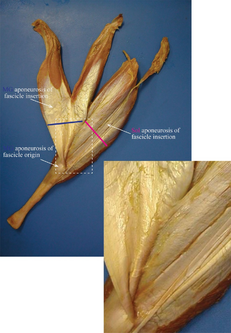Myotendinous Junction: Difference between revisions
No edit summary |
No edit summary |
||
| Line 23: | Line 23: | ||
== US and MRI == | == US and MRI == | ||
For correct diagnosis and prognosis a grading system of MTJ injuries was created | For correct diagnosis and prognosis a grading system of MTJ injuries was created, for use when using [[MRI Scans|MRI]] or [[Ultrasound Scans|US]] scans. | ||
# Mild [[Muscle Strain|strain]]: feathery interstitial edema and fluid/hemorrhage around the MTJ | # Mild [[Muscle Strain|strain]]: feathery interstitial edema and fluid/hemorrhage around the MTJ | ||
Revision as of 09:36, 12 June 2022
Original Editor - Lucinda hampton
Top Contributors - Lucinda hampton
Introduction[edit | edit source]
Myotendinous junction (MTJ) is a part of the myotendinous unit, which connects muscle and tendon, and transmits forces between them (the myotendinous unit consisting usually of bone, enthesis, tendon, myotendinous junction and muscle[1])
The MTJ has a unique morphology with a highly folded muscle membrane filled with invaginations of collagen fibrils from the tendon. This creates an increased area of force transmission between muscle and tendon and, as a result, disperses the energy of a contracting muscle, decreasing focal stress[2][3].
During muscle activity and mainly during high effort exercise, large forces are transmitted from muscle fibers to the tendon through the MTJ. It is a common location for strain injuries in sports. Most of these can be prevented by heavy eccentric exercise[3].
- In animals, the size and number of foldings are increased as a response to heavy training and reduced during inactivity.
- In humans, the muscle fibers near the MTJ show very high rates of remodeling compared to other regions of the muscle.
Physiotherapy Implications[edit | edit source]
In a healthy adult, the MTJ is the weakest region of the myotendinous unit and for that reason it is its most commonly injured part.
- The highest risk of strain occurs in large pennate muscles that cross two joints and produce large tensile forces e.g. biceps femoris, quadratus femoris, biceps brachii[2].
- With aging there is shortening of the interdigitations with a resulting decrease in contact area between the sarcolemma and extracellular components.[4]
US and MRI[edit | edit source]
For correct diagnosis and prognosis a grading system of MTJ injuries was created, for use when using MRI or US scans.
- Mild strain: feathery interstitial edema and fluid/hemorrhage around the MTJ
- Moderate strain: intramuscular hematoma and perifascial fluid/hemorrhage
- Severe strain: MTJ tear with laxity/discontinuity of the tendon and muscle ends, sometimes with retraction
Scar tissue, old blood products and atrophy/fatty degeneration of the muscle are indicative of an old strain[2].
References[edit | edit source]
- ↑ Radiopedia Myotendinous unit Available: https://radiopaedia.org/articles/myotendinous-unit?lang=us(accessed 12.6.2022)
- ↑ 2.0 2.1 2.2 Radiopedia Myotendinous junction Available:https://radiopaedia.org/articles/myotendinous-junction?lang=us (accessed 12.6.2022)
- ↑ 3.0 3.1 Jakobsen JR, Krogsgaard MR. The Myotendinous Junction—A Vulnerable Companion in Sports. A Narrative Review. Frontiers in physiology. 2021;12. Available;https://www.frontiersin.org/articles/10.3389/fphys.2021.635561/full (accessed 12.6.2022)
- ↑ Wikimsk MTJ Available:https://wikimsk.org/wiki/Myotendinous_Junction (accessed 12.6.2022)








